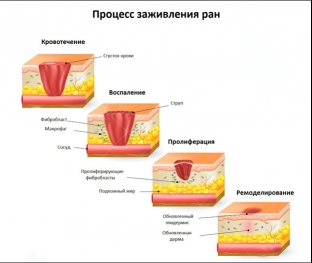The main feature of aesthetic surgery is that in this branch of medicine the surgeon works not with pathology, but with healthy tissues that have undergone physiological age-related changes. The doctor has to damage them during the operation in order to achieve the desired result: restore youth and restore beauty to the patient. Damage to the skin throughout its entire thickness is a wound, and wounds tend to heal with the subsequent formation of scars. But in aesthetic surgery, scars – this is an extremely undesirable consequence, the occurrence of which doctors are trying with all their might to avoid. Find out what features of skin wound healing must be considered in aesthetic surgery.
How the wound healing process affects the results of plastic surgery
The wound healing process is a cascade of reactions and intercellular interactions that begin with the release of blood cells directly into the wound. The process continues with the formation of granulation tissue, its contraction and subsequent remodeling into scar tissue. This process is a physiological response to tissue injury, which always occurs in the postoperative period. For aesthetic surgeons, it is especially important to influence the wound healing process and, in particular, the formation of scars. An in-depth knowledge of the basic mechanisms of tissue repair allows doctors to control the scarring process and to some extent influence its outcome.
Wound healing:
- main ways of skin wound healing;
- what phases are isolated in the process of wound healing;
- can a plastic surgeon influence the healing process of wounds.
The main ways of healing wounds on the skin
There are several ways of healing wounds on the skin, the choice of each of which may be more preferable after certain surgical interventions:
- primary tension – this way wound healing occurs in cases where the wound is sutured with direct comparison of its edges or closed with flaps or skin grafts;
- secondary tension – is the spontaneous healing of wounds on the skin. Characteristic of those surgical wounds that are left open, and depends on the degree of epithelialization and contraction of the wound;
- tertiary tension – this is another way of wound healing that is distinguished by American surgeons. In this case, delayed closure of the wound with secondary sutures is performed a few days after its occurrence.
Which phases are isolated in the process of wound healing
Wound healing – it is a complex and lengthy process that goes through certain stages. Knowledge of these phases is important for aesthetic surgeons, since it is quite difficult to influence scar formation over time. In the process of wound healing allocate three phase:
- inflammatory phase, or phase of substrates – this phase lasts about 4 days for primary wound healing, or longer for secondary wound healing, until the entire surface of the wound is covered;
- the proliferative phase lasts from 4 to 42 days and is characterized by the release of fibroblasts and the formation of collagen;
- The maturation and remodeling phase of the scar begins 6 weeks after skin injury and lasts approximately 9 months in adults and approximately one year in children.

Can a plastic surgeon influence the wound healing process
In order to avoid the formation of an obvious scar, aesthetic surgeons who know the characteristics of wound healing can influence this process. There are local factors that doctors can control to some extent. These include:
- minimizing trauma to healthy tissue;
- prevention of hematomas, dangerous in terms of infectious complications and tissue deformities;
- degree of tissue ischemia and nature of their blood supply;
- level of wound contamination;
- Suture selection.
Aesthetic surgeons cannot influence general factors, but they can and must take them into account. These factors include the constant use of steroid hormones, chronic diseases of the patient, as well as his overweight.







Add a comment